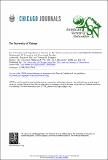Files in this item
Sex allocation and reproductive success in the andromonoecious perennial, Solanum carolinense (Solanaceae). II. paternity and functional gender
Item metadata
| dc.contributor.author | Elle, E | |
| dc.contributor.author | Meagher, Thomas Robert | |
| dc.date.accessioned | 2014-08-12T14:01:01Z | |
| dc.date.available | 2014-08-12T14:01:01Z | |
| dc.date.issued | 2000-12 | |
| dc.identifier | 94570 | |
| dc.identifier | 13a5bfc2-d2b2-473e-8714-8aff77e0128a | |
| dc.identifier | 000165870000005 | |
| dc.identifier | 0034537848 | |
| dc.identifier.citation | Elle , E & Meagher , T R 2000 , ' Sex allocation and reproductive success in the andromonoecious perennial, Solanum carolinense (Solanaceae). II. paternity and functional gender ' , American Naturalist , vol. 156 , no. 6 , pp. 622-636 . https://doi.org/10.1086/316997 | en |
| dc.identifier.issn | 1537-5323 | |
| dc.identifier.uri | https://hdl.handle.net/10023/5122 | |
| dc.description | The work was supported by a National Science Foundation Doctoral Dissertation Improvement grant (DEB‐9411513), by the Society for Sigma Xi, and by a Hutcheson Memorial Forest grant. | en |
| dc.description.abstract | According to Bateman's principle, male fitness in entomophilous plant species should be limited by mating opportunity, which is influenced by the size or number of flowers. We determined male-specific fitness consequences of floral phenotype in andromonoecious Solanum carolinense, examined the relationship between male and female reproductive success within plants, and evaluated the distribution of functional gender among plants. A maximum likelihood-based paternity analysis, based on multilocus allozyme phenotypes of parents and offspring from four experimental plots, was used to determine male reproductive success and its relationship to floral phenotype. Male success was enhanced by an increase in the proportion of male flowers produced but not by an increase in total flower number, even though all flowers contain male parts. Larger flower size increased male success in only one plot. Male and female reproductive success were negatively correlated, and plants varied in functional gender from completely female to completely male. This gender specialization may occur because hermaphroditic and male flowers differ in their ability to contribute to male and female success. Although sex allocation theory predicts a positive relationship between the size or number of plant parts and reproductive success, this study indicates that aspects of floral morphology that affect gender specialization should also be considered. | |
| dc.format.extent | 15 | |
| dc.format.extent | 300497 | |
| dc.language.iso | eng | |
| dc.relation.ispartof | American Naturalist | en |
| dc.subject | Andromonoecy | en |
| dc.subject | Bateman's principle | en |
| dc.subject | Functional gender | en |
| dc.subject | Paternity analysis | en |
| dc.subject | Sex allocation | en |
| dc.subject | Solanum carolinense | en |
| dc.subject | Mediated gene flow | en |
| dc.subject | Radish raphanus-raphanistrum | en |
| dc.subject | Pollen-donation hypothesis | en |
| dc.subject | Wild radish | en |
| dc.subject | Chamaelirium-luteum | en |
| dc.subject | Natural-population | en |
| dc.subject | Asclepias-exaltata | en |
| dc.subject | Floral traits | en |
| dc.subject | Dispersal patterns | en |
| dc.subject | Parentage analysis | en |
| dc.subject | QH301 Biology | en |
| dc.subject.lcc | QH301 | en |
| dc.title | Sex allocation and reproductive success in the andromonoecious perennial, Solanum carolinense (Solanaceae). II. paternity and functional gender | en |
| dc.type | Journal article | en |
| dc.contributor.institution | University of St Andrews. School of Biology | en |
| dc.contributor.institution | University of St Andrews. Scottish Oceans Institute | en |
| dc.identifier.doi | https://doi.org/10.1086/316997 | |
| dc.description.status | Peer reviewed | en |
| dc.identifier.url | http://www.scopus.com/inward/record.url?scp=0034537848&partnerID=8YFLogxK | en |
| dc.identifier.url | http://www.journals.uchicago.edu/AN/ | en |
This item appears in the following Collection(s)
Items in the St Andrews Research Repository are protected by copyright, with all rights reserved, unless otherwise indicated.

